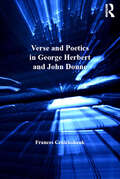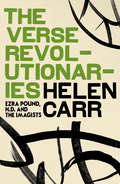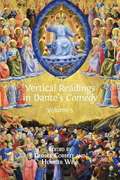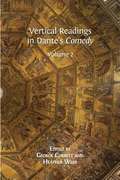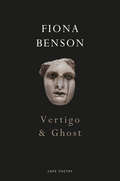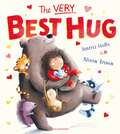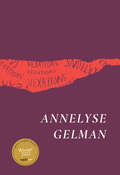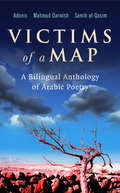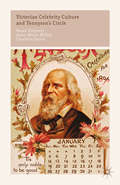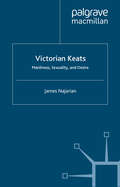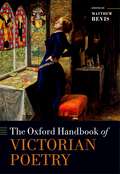- Table View
- List View
Verse and Poetics in George Herbert and John Donne
by Frances CruickshankInnovative and highly readable, this study traces George Herbert's and John Donne's development of a distinct poetics through close readings of their poems, references to their letters, sermons, and prose treatises, and to other contemporary poets and theorists. In demonstrating a relationship between poetics and religious consciousness in Donne's and Herbert's verse, Frances Cruickshank explores their attitudes to the cultural, theological, and aesthetic enterprise of writing and reading verse. Cruickshank shows that Donne and Herbert regarded poetry as a mode not determined by its social and political contexts, but as operating in and on them with its own distinct set of aesthetic and intellectual values, and that ultimately, verse mattered as a privileged mode of religious discourse. This book is an important contribution to the ongoing scholarly dialogue about the nature of literary and cultural study of early modern England, and about the relationship between the writer and the world. Cruickshank confirms Donne's reputation as a fascinating and brilliant poetic figure while simultaneously rousing interest in Herbert by noting his unique merging of rusticity and urbanity and tranquility and uncertainty, allowing the reader to enter into these poets' imaginative worlds and to understand the literary genre they embraced and then transformed.
The Verse Revolutionaries: Ezra Pound, H.D. and The Imagists
by Helen CarrThe Verse Revolutionaries tells the story of the Imagists, a turbulent and colourful group of poets, who came together in London in the years before the First World War. As T. S. Eliot was to say, appropriately re-invoking the Imagist habit of turning anything they admired into French, the imagist movement was modern poetry's point de repère, the landmark venture that inaugurated Anglo-American literary modernism. A disparate, stormy group, who had dispersed before the twenties began, these 'verse revolutionaries' received both abuse and acclaim, but their poetry, fragmented, pared-down, elliptical yet direct, exerted a powerful influence on modernist writers, and contributed vitally to the transformation of American and British cultural life in those crucial years.Among those involved were the Americans Ezra Pound, H.D., William Carlos Williams, Amy Lowell and John Gould Fletcher, and the British T.E. Hulme, F.S. Flint, Richard Aldington and D.H. Lawrence. On the edges of the story are figures such as W.B. Yeats, Ford Madox Ford, Wyndham Lewis and T. S. Eliot. They came from very different class backgrounds, a heterogeneous mélange then only possible in a great metropolis like London. The Verse Revolutionaries traces the passionate interactions, love affairs and bitter quarrels of these aspiring poets from 1905 to 1917. Helen Carr unpicks the story of how they came together, what they gained from each other in the heady excitement of those early days, and what were the fissures that eventually broke up the movement and their friendships in the dark days of the Great War. Her compelling account challenges the conventional view of Imagism, and offers an acute analysis of the poetry, of the psychology of the individuals involved, and of the evolution and emergence of a transformative cultural movement.
A Vertical Art: On Poetry
by Simon ArmitageFrom the UK Poet Laureate and bestselling translator, a spirited book that demystifies and celebrates the art of poetry todayIn A Vertical Art, acclaimed poet Simon Armitage takes a refreshingly common-sense approach to an art form that can easily lend itself to grand statements and hollow gestures. Questioning both the facile and obscure ends of the poetry spectrum, he offers sparkling new insights about poetry and an array of favorite poets.Based on Armitage’s public lectures as Oxford Professor of Poetry, A Vertical Art illuminates poets as varied as Emily Dickinson, Walt Whitman, Marianne Moore, W. H. Auden, Ted Hughes, Thom Gunn, A. R. Ammons, and Claudia Rankine. The chapters are often delightfully sassy in their treatment, as in “Like, Elizabeth Bishop,” in which Armitage dissects—and tallies—the poet’s predilection for similes. He discusses Bob Dylan’s Nobel Prize, poetic lists, poetry and the underworld, and the dilemmas of translating Sir Gawain and the Green Knight. Armitage also pulls back the curtain on the unromantic realities of making a living as a contemporary poet, and ends the book with his own list of “Ninety-Five Theses” on the principles and practice of poetry.An appealingly personal book that explores the volatile and disputed definitions of poetry from the viewpoint of a practicing writer and dedicated reader, A Vertical Art makes an insightful and entertaining case for the power and potential of poetry today.
A Vertical Art: On Poetry
by Simon ArmitageFrom the UK Poet Laureate and bestselling translator, a spirited book that demystifies and celebrates the art of poetry todayIn A Vertical Art, acclaimed poet Simon Armitage takes a refreshingly common-sense approach to an art form that can easily lend itself to grand statements and hollow gestures. Questioning both the facile and obscure ends of the poetry spectrum, he offers sparkling new insights about poetry and an array of favorite poets.Based on Armitage’s public lectures as Oxford Professor of Poetry, A Vertical Art illuminates poets as varied as Emily Dickinson, Walt Whitman, Marianne Moore, W. H. Auden, Ted Hughes, Thom Gunn, A. R. Ammons, and Claudia Rankine. The chapters are often delightfully sassy in their treatment, as in “Like, Elizabeth Bishop,” in which Armitage dissects—and tallies—the poet’s predilection for similes. He discusses Bob Dylan’s Nobel Prize, poetic lists, poetry and the underworld, and the dilemmas of translating Sir Gawain and the Green Knight. Armitage also pulls back the curtain on the unromantic realities of making a living as a contemporary poet, and ends the book with his own list of “Ninety-Five Theses” on the principles and practice of poetry.An appealingly personal book that explores the volatile and disputed definitions of poetry from the viewpoint of a practicing writer and dedicated reader, A Vertical Art makes an insightful and entertaining case for the power and potential of poetry today.
A Vertical Art: Oxford Lectures
by Simon ArmitageThis edition gathers the expansive and spirited public lectures delivered by Simon Armitage during his 'conscientious and often amusingly self-conscious tenure' (TLS) as Oxford University Professor of Poetry. Armitage tries to identify a 'common sense' approach to an artform that can lend itself to grand statements and vacuous gestures, questioning both the facile and obscure ends of the poetry spectrum, asserting certain fundamental qualities that separate the genre from near-neighbours such as prose and song lyrics, examining who poetry is written for and its values in contemporary society. Above all, these are personal essays that enquire into the volatile and disputed definitions of poetry from the point of view of a dedicated reader, a practising writer and a lifelong champion of its power and potential.
Vertical Readings in Dante's Comedy: Volume 2
by George Corbett Heather WebbThis collection – to be issued in three volumes – offers an unprecedented repertoire of vertical readings for the whole poem. As the first volume exemplifies, vertical reading not only articulates unexamined connections between the three canticles but also unlocks engaging new ways to enter into core concerns of the poem. The three volumes thereby provide an indispensable resource for scholars, students and enthusiasts of Dante. The volume has its origin in a series of thirty-three public lectures held in Trinity College, the University of Cambridge (2012-2016) which can be accessed at the Cambridge Vertical Readings in Dante’s Comedy website.
Vertical Readings in Dante's Comedy: Volume 2
by George Corbett And Heather WebbVertical Readings in Dante’s Comedy is a reappraisal of the poem by an international team of thirty-four scholars. Each vertical reading analyses three same-numbered cantos from the three canticles: Inferno i, Purgatorio i and Paradiso i; Inferno ii, Purgatorio ii and Paradiso ii; etc. Although scholars have suggested before that there are correspondences between same-numbered cantos that beg to be explored, this is the first time that the approach has been pursued in a systematic fashion across the poem. This collection – to be issued in three volumes – offers an unprecedented repertoire of vertical readings for the whole poem. As the first volume exemplifies, vertical reading not only articulates unexamined connections between the three canticles but also unlocks engaging new ways to enter into core concerns of the poem. The three volumes thereby provide an indispensable resource for scholars, students and enthusiasts of Dante.
Vertical Readings in Dante's Comedy: Volume 3
by George Corbett And Heather WebbVertical Readings in Dante’s Comedy is a reappraisal of the poem by an international team of thirty-four scholars. Each vertical reading analyses three same-numbered cantos from the three canticles: Inferno i, Purgatorio i and Paradiso i; Inferno ii, Purgatorio ii and Paradiso ii; etc. Although scholars have suggested before that there are correspondences between same-numbered cantos that beg to be explored, this is the first time that the approach has been pursued in a systematic fashion across the poem. This collection in three volumes offers an unprecedented repertoire of vertical readings for the whole poem. As the first volume exemplifies, vertical reading not only articulates unexamined connections between the three canticles but also unlocks engaging new ways to enter into core concerns of the poem. The three volumes thereby provide an indispensable resource for scholars, students and enthusiasts of Dante. The volume has its origin in a series of thirty-three public lectures held in Trinity College, the University of Cambridge (2012-2016) which can be accessed at the Cambridge Vertical Readings in Dante’s Comedy website.
Vertical Readings in Dante’s Comedy: Volume 1 (PDF)
by George Corbett Heather WebbVertical Readings in Dante's Comedy is a reappraisal of the poem by an international team of thirty-four scholars. Each vertical reading analyses three same-numbered cantos from the three canticles: Inferno i, Purgatorio i and Paradiso i; Inferno ii, Purgatorio ii and Paradiso ii; etc. Although scholars have suggested before that there are correspondences between same-numbered cantos that beg to be explored, this is the first time that the approach has been pursued in a systematic fashion across the poem. This collection - to be issued in three volumes - offers an unprecedented repertoire of vertical readings for the whole poem. As the first volume exemplifies, vertical reading not only articulates unexamined connections between the three canticles but also unlocks engaging new ways to enter into core concerns of the poem. The three volumes thereby provide an indispensable resource for scholars, students and enthusiasts of Dante.
Vertical Readings in Dante’s Comedy: Volume 3 (PDF)
by George Corbett Heather WebbVertical Readings in Dante’s Comedy is a reappraisal of the poem by an international team of thirty-four scholars. Each vertical reading analyses three same-numbered cantos from the three canticles: Inferno i, Purgatorio i and Paradiso i; Inferno ii, Purgatorio ii and Paradiso ii; etc. Although scholars have suggested before that there are correspondences between same-numbered cantos that beg to be explored, this is the first time that the approach has been pursued in a systematic fashion across the poem. This collection in three volumes offers an unprecedented repertoire of vertical readings for the whole poem. As the first volume exemplifies, vertical reading not only articulates unexamined connections between the three canticles but also unlocks engaging new ways to enter into core concerns of the poem. The three volumes thereby provide an indispensable resource for scholars, students and enthusiasts of Dante. The volume has its origin in a series of thirty-three public lectures held in Trinity College, the University of Cambridge (2012-2016) which can be accessed at the Cambridge Vertical Readings in Dante’s Comedy website.
Vertical Readings in Dante’s Comedy: Volume 2 (PDF)
by George Corbett Heather WebbVertical Readings in Dante’s Comedy is a reappraisal of the poem by an international team of thirty-four scholars. Each vertical reading analyses three same-numbered cantos from the three canticles: Inferno i, Purgatorio i and Paradiso i; Inferno ii, Purgatorio ii and Paradiso ii; etc. Although scholars have suggested before that there are correspondences between same-numbered cantos that beg to be explored, this is the first time that the approach has been pursued in a systematic fashion across the poem. This collection – to be issued in three volumes – offers an unprecedented repertoire of vertical readings for the whole poem. As the first volume exemplifies, vertical reading not only articulates unexamined connections between the three canticles but also unlocks engaging new ways to enter into core concerns of the poem. The three volumes thereby provide an indispensable resource for scholars, students and enthusiasts of Dante. The volume has its origin in a series of thirty-three public lectures held in Trinity College, the University of Cambridge (2012-2016) which can be accessed at the Cambridge Vertical Readings in Dante’s Comedy website.
Vertigo & Ghost
by Fiona Benson**WINNER OF THE FORWARD PRIZE FOR BEST COLLECTION 2019****WINNER OF THE ROEHAMPTON PRIZE FOR BEST POETRY COLLECTION 2019****SHORTLISTED FOR THE 2019 T. S. ELIOT PRIZE**Violence hangs over this book like an electric storm. Beginning with a poem about the teenage dawning of sexuality, Vertigo & Ghost pitches quickly into a long sequence of graphic, stunning pieces about Zeus as a serial rapist, for whom woman are prey and sex is weaponised. These are frank, brilliant, devastating poems of vulnerability and rage, and as Zeus is confronted with aggressions both personal and historical, his house comes crumbling down. A disturbing contemporary world is exposed, in which violent acts against women continue to be perpetrated on a daily – hourly – basis. The book shifts, in its second half, to an intimate and lyrical document of depression and family life. It sounds out the complex and ambivalent terrain of early motherhood – its anxieties and claustrophobias as well as its gifts of tenderness and love – reclaiming the sanctuary of domestic private life, and the right to raise children in peace and safety. Vertigo & Ghost is an important, necessary book, hugely impressive in its range and risk, and dramatic in its currency: a collection that speaks out with clarity, grace and bravery against the abuse of power.
Verwurzelungen. Sarah Kirsch (Abhandlungen zur Literaturwissenschaft)
by Jana Kittelmann Stephan Pabst Mike RottmannSarah Kirsch (1935-2013) zählt zu den bedeutendsten deutschsprachigen Dichterinnen. Erfolgreiche Lyrikbände wie „Zaubersprüche“ und „Erlkönigs Tochter", die Interviewsammlung „Die Pantherfrau“ oder die Erzählung „Allerlei-Rauh“ haben die gesamtdeutsche Literaturlandschaft nachhaltig beeinflusst. Kirsch hinterließ ein vielfältiges Werk, das neben Gedichten auch Briefwechsel, Tagebuchaufzeichnungen, Reiseberichte, Feuilletonbeiträge, kleinere Prosatexte, Übersetzungen, Zeichnungen und Aquarelle umfasst. Der Sammelband arbeitet mehr als zehn Jahre nach dem Tod der Dichterin die fortwährende Brisanz und Aktualität ihres Werks heraus, das von dem unverwechselbaren „Sarah-Sound" (Peter Hacks) ebenso geprägt ist wie von einer präzisen und zugleich visionären Wahrnehmung von Natur und deren Gefährdung.
The Very Best Hug
by Smriti HallsHave you ever wondered who gives the very BEST hug? The kind that feels just right?Get ready to join us on a mission to find the PERFECT hug. From bear hugs to koala cuddles, hippo huddles to walrus wiggles, penguin pecks to porcupine prickles, there are a LOT of hugs to choose from. But sometimes, the very best hug is the one that comes from the people you love most.Full of chaotic animal cuddles, this irresistible story from award-winning author Smriti Halls is perfect for sharing and reading aloud. Warning: You may want to hug this book!
The Very Best of Paul Cookson: Let No One Steal Your Dreams and Other Poems
by Paul CooksonThe Very Best of Paul Cookson brings together twenty-five years of poetry. It includes his favourite poems and his most thoughtful, uplifting and memorable poems. Includes Let No One Steal Your Dreams, Father's Hands, May You Always, Invisible Magicians, This is Our School and many more.
Vexations (Phoenix Poets)
by Annelyse GelmanA mother and daughter journey together through a strange speculative world in this experimental book-length poem. Annelyse Gelman’s book-length poem Vexations is a surreal, glitchy meditation on empathy, ecology, and precarity. Throughout the book winds a narrative about a mother and daughter as they move through a world of social and economic collapse in search of a post-capitalist safe haven. All the while, they also navigate a condition that affects the daughter’s empathic abilities, making her vulnerable to emotional contagion. Vexations is titled and structured after Erik Satie’s composition of the same name, a piece that requires patience, endurance, and concentration from both its audience and its players. Similarly, Gelman’s Vexations employs repetition and variation to engage the reader’s attention. Hers is an ambient poetry, drawing on the aesthetic qualities of drone music and sampling voices and sounds to create a lush literary backdrop filled with pulsing psychedelic detail.
Vexations (Phoenix Poets)
by Annelyse GelmanA mother and daughter journey together through a strange speculative world in this experimental book-length poem. Annelyse Gelman’s book-length poem Vexations is a surreal, glitchy meditation on empathy, ecology, and precarity. Throughout the book winds a narrative about a mother and daughter as they move through a world of social and economic collapse in search of a post-capitalist safe haven. All the while, they also navigate a condition that affects the daughter’s empathic abilities, making her vulnerable to emotional contagion. Vexations is titled and structured after Erik Satie’s composition of the same name, a piece that requires patience, endurance, and concentration from both its audience and its players. Similarly, Gelman’s Vexations employs repetition and variation to engage the reader’s attention. Hers is an ambient poetry, drawing on the aesthetic qualities of drone music and sampling voices and sounds to create a lush literary backdrop filled with pulsing psychedelic detail.
Victims of a Map: A Bilingual Anthology of Arabic Poetry (Adonis, Mahmud Darwish, Samih al-Qasim)
by Adonis Mahmud Darwish Samih al-QasimMahmud Darwish, Samih al-Qasim and Adonis are amongst the leading poets in the Arab world today.Victims of a Map presents some of their finest work in translation, alongside the original Arabic, including thirteen poems by Darwish never before published – in English or Arabic – and a long work by Adonis written during the 1982 siege of Beirut, also published here for the first time.
Victorian Celebrity Culture and Tennyson's Circle
by C. Boyce P. Finnerty A. MillimTennyson experienced at first hand the all-pervasive nature of celebrity culture. It caused him to retreat from the eyes of the world. This book delineates Tennyson's reluctant celebrity and its effects on his writings, on his coterie of famous and notable friends and on the ever-expanding, media-led circle of Tennyson's admirers.
Victorian Keats: Manliness, Sexuality and Desire
by J. NajarianThis book explores the sexual implications of reading Keats. Keats was lambasted by critics throughout the nineteenth century for his sensuousness and his 'effeminacy'. The Victorians simultaneously identified with, imitated, and distrusted the 'unmanly' poet. Writers, among them Alfred Lord Tennyson, Matthew Arnold, Gerard Manley Hopkins, John Addington Symonds, Walter Pater, and Wilfred Owen came to terms with Keats's work by creating out of the 'effeminate' poet a sexual and literary ally.
Victorian Poetry (Oxford Handbooks Ser.)
by Matthew Bevis Sir James Dingemans'I am inclined to think that we want new forms . . . as well as thoughts', confessed Elizabeth Barrett to Robert Browning in 1845. The Oxford Handbook of Victorian Poetry provides a closely-read appreciation of the vibrancy and variety of Victorian poetic forms, and attends to poems as both shaped and shaping forces. The volume is divided into four main sections. The first section on 'Form' looks at a few central innovations and engagements—'Rhythm', 'Beat', 'Address', 'Rhyme', 'Diction', 'Syntax', and 'Story'. The second section, 'Literary Landscapes', examines the traditions and writers (from classical times to the present day) that influence and take their bearings from Victorian poets. The third section provides 'Readings' of twenty-three poets by concentrating on particular poems or collections of poems, offering focused, nuanced engagements with the pleasures and challenges offered by particular styles of thinking and writing. The final section, 'The Place of Poetry', conceives and explores 'place' in a range of ways in order to situate Victorian poetry within broader contexts and discussions: the places in which poems were encountered; the poetic representation and embodiment of various sites and spaces; the location of the 'Victorian' alongside other territories and nationalities; and debates about the place - and displacement - of poetry in Victorian society. This Handbook is designed to be not only an essential resource for those interested in Victorian poetry and poetics, but also a landmark publication—provocative, seminal volume that will offer a lasting contribution to future studies in the area.
Victorian Poetry and Modern Life: The Unpoetical Age (Palgrave Studies in Nineteenth-Century Writing and Culture)
by Natasha MooreFaced with the chaos and banality of modern, everyday life, a number of Victorian poets sought innovative ways of writing about the unpoetic present in their verse. Their varied efforts are recognisably akin, not least in their development of mixed verse-forms that fused novel and epic to create something equal to the miscellaneousness of the age.
